It’s possible that Krakow has become my favorite city–not just in Europe, but anywhere. Out of all of the places I’ve visited, I’ve never left saying , “I will go back to that city one day.”
But believe me when I say– I will go back to Krakow. I would dare say I miss Krakow… and I was only there for five days!
As I mentioned in my previous post which you can find HERE, I’ve become obsessed with this city. I could go on and on and on about it.
But, for the sake of not rambling too much (at one time) I’m going to try to divide up my blog posts about our trip to Krakow into small, more easy-to-mannage, reader-friendly chunks.
In this chunk–let’s call it “Krakow chunk 1”– I’m simply going to focus on the essentials. Your basic “travel musts” if you will. It will be a general, brief, description of some of the amazing things the city has to offer.
Must do’s in Krakow
- Market Square
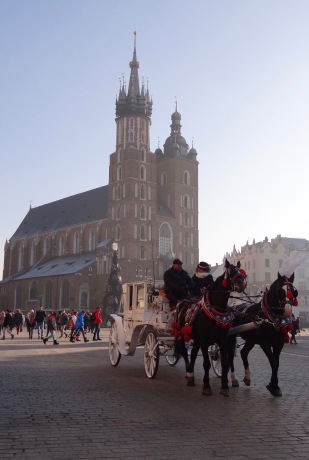
This attraction is impossible to miss. I don’t mean that in the “you have to go to this place” sense. I literally mean, it would be impossible to go to Krakow and not visit the Market Square.
It’s the heart of Krakow’s old town. Although two of the major attractions the city has to offer are found in Market Square, it’s worth noting that this breathtakingly beautiful square is an attraction in its own right.
One of the oldest Medieval markets in all of Europe, this bustling city center perfectly represents the melting together of the past with the present, the modern day world nestled into the historic backdrop of the cultural capital of Poland.
- The Cloth Hall
This is one of those two sites found in the Market Square that I mentioned earlier. Located in the very center of the city’s main square, the Cloth Hall dates back to the Renaissance.
Originally serving as the place where merchants from all over the world came to buy, sell, and trade their goods, this iconic site is still up and running. Now, visitors can venture down the long hall (seriously, it’s literally a long hall) in search of handmade goods, souvenirs, and a plethora of other little trinkets to bring back home for their loved ones.
- St. Mary’s Basilica
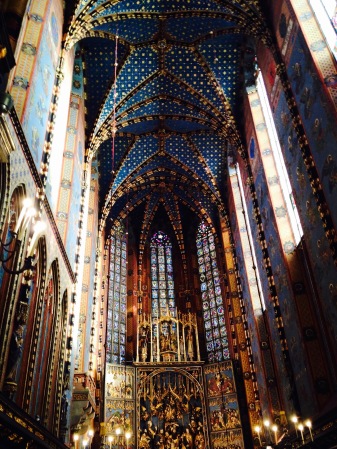
The second major site in the Market Square is also impossible to miss. The large gothic towers of this 14th century church hover over the bustling crowds busily hurrying to-and-fro through the heart of Krakow’s old town.
I will honestly say, I’ve been in a lot of churches during my trips around Europe. But, this one–this one still filled me with a complete sense of awe. The ornate altarpiece and brightly colored ceilings were simply astonishing.
- Kazimierz- Jewish Quarter
The old Jewish Ghetto, this once devastated part of the city is now a lively, upbeat, can’t miss part of town. With restaurants, historical sites, and quaint little streets just begging to be explored, it’s a true tribute to how far we’ve come since the devastation that once ravished this area in the 1940s.
- Wawel Castle
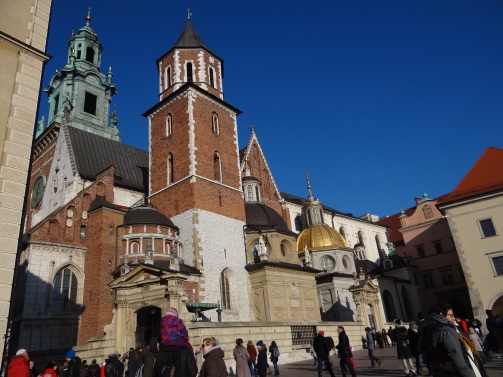
My picture does not do it justice…
This is the quintessentially iconic piece of Krakow’s past. It represents all of the major moments in Poland’s history–from the once great land, to subjects of foreign rule, to now prosperous, independant country.
Built in the 14th Century, this major landmark transports visitors back in time, to a world of kings and princesses, knights and dragons.
Yes, you heard me right–dragons.
One thing you will immediately notice upon visiting the previous (albeit, still cultural) capital of Poland is the local obsession with dragons. Or, should I say, dragon–one in particular.
Let’s take a moment to talk about this wonderfully romantic tale that Krakow so proudly boasts:
Smok the Dragon
Legend has it that Krakow was, way back in the day–I’m talking Medieval times sort of “back in the day”–the ideal place to live. The king was gracious, the princess beautiful, and the commoners lived happy, fulfilling lives.
That all came to a sudden halt, though, when a dragon decided to take up residence in the mountains surrounding the city.
His name was Smok.
Smok tormented the villagers, and the king was desperate to find a way to once again bring peace to the land… It sounds like something out of a Disney movie, doesn’t it?
I’m not going to give away the good part–the end. But, believe me when I say that the symbol of the “Smok the dragon” is still very much a part of modern day Krakow. It’s become somewhat commercialized, of course, but it’s still a fantastical tale that will fill adults and children alike with the sense of wonderment that so often comes when stepping into such a historic, romantic place.
Getting back to Wawel Castle…
There are various sections of the Castle to see. My hubby and I chose to simply wander around the grounds. We had hoped to return to the Castle to go inside and venture around some more. But, quite simply… we ran out of time!
One of the sections of the grounds were didn’t get to explore (that I really wanted to, even though it’s for kids–I’m still a child at heart) was the Dragon’s Den. It was closed at the time that we visited, but that was because we went on January 1st (our mistake).
Still, this remarkably beautiful building and its extensive history carries with it a sense of magic and allure that will surely appeal to any lover of history and/or fantasy.
- Schindler’s Factory
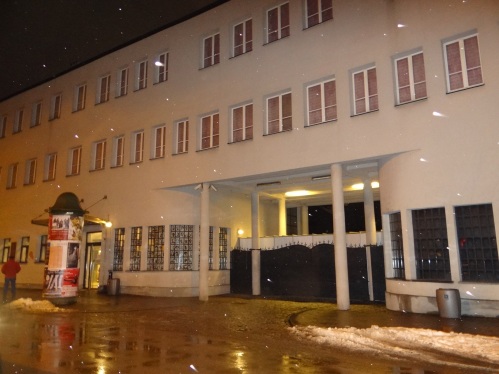
Let me begin this by saying–this is by far the most impressive museum I have ever been in. Hubby and I spent two hours there, and I could have happily spent two more.
The site of the historic kitchenware factory owned and operated by Nazi party member Oskar Schindler, this building has been imortilazed in Spielberg’s dramatic, very historically accurate film Schindler’s List. And, with good reason. Although he started out as nothing more than an entrepreneur looking to make money during wartime, Schindler quickly developed emotional ties to his Jewish employees.
It was because of those ties and the employment he offered them in his factory, that 1,200 Jews were allowed to reamin in Krakow and not suffer the attrocities taking place not too far away in Auschwitz.
The museum, installed inside the factory walls, has an amazing way of portraying, both visually and emotionally, the realities of what was happening in Poland (and all of Europe) during WWII. It is hard to not get completely lost in the exhibits, designed with so much detail and precision.
Note: If you havne’t, you should definitely watch Schindler’s List before venturing to this site.
- The Salt Mines
I will be honest–hubby and I didn’t get the chance to visit this common Krakow attraction. We bought our tickets (both entrance tickets and the train tickets to get out there–it’s only about 3o minutes away), but due to the frigid cold that had settled over Poland while we were visiting, we opted to stay in the city center, huddled up in local shops, restaurants, and bars instead.
*Note: We were doubly inclined to avoid the cold because we had visited Auschwitz the day before (see next point) and were still in the process of defrosting.
Regardless, the things we had heard about the Salt Mines litterally beckoned us to explore them. Caverns filled with carved statues–all made of the savory substance. Ornately decorated chaples, contamporary art sprinkled in along the way…
If I have one regret from this vacation, it was that I didn’t suck it up and take the trip to explore the Wielczka Salt Mine.
To get there: As I said, we did buy our train tickets to the Salt Mines, even though we didn’t go. The process of getting them is very easy. The train and bus stations are extremely easy to find. I’ll talk about this at the very end of this post, so stay tuned!
- Auschwitz
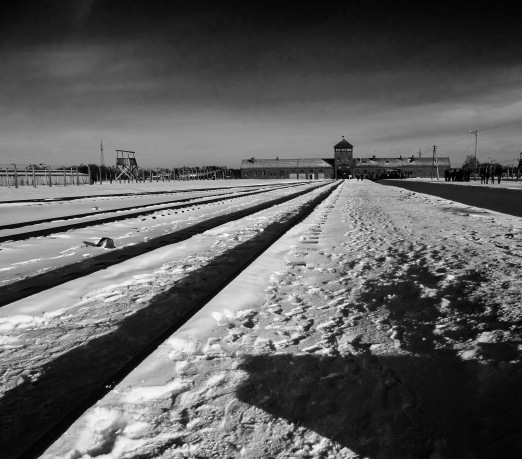
Probably the most infamous of all the Nazi concentration camps, Auschwitz is located about an hour and a half outside of Krakow.
I won’t go into too much detail about our visit there in this post as I’ll write a seperate one dedicated solely to the topic–I think it more than deserves it.
What I will say, though, is if you’re planning to venture out to this historic site plan to be there all day. The trip from Krakow to Auschwitz takes about an hour and a half. The tour, if you choose to do one (which I recommened) lasts about 3 hours. So, total, you’re going to need to dedicate at least six hours to this excursion.
And if you’re going in winter–bundle up! Most of the tour is out doors.
How to get there: What we did was this: We simply went to the bus station and got on the bus. Seriously, that’s all we did.
We didn’t have to buy our tickets in advance, since the buses run so regularly. You can find the schedules online, which will prove to be very useful because you want to get there early.
Here’s how it played out for us. We got to the station and began standing in line at the ticket counter. Our tour was at 12:30, so we had decided to take the 11:00 bus. This was not good planning on our part (by the time we got there, our group had already begun the tour, and we missed out on the first 15 mintues of it) .
Either way, we were standing in line when we overheard the couple behind us talking. They were also going to Auschwitz, and the woman was encouraging her husband to ask at the information desk if they were in the right place.
He asked. We weren’t.
For the specific bus we were taking, we had to go downstairs and wait for the bus at the stall. It’s a small bus, but it says Auschwitz right on it, so it was easy to spot. There, we bought our tickets from the driver and took our seats.
And the bus began to fill up. And it filled, and it filled, and it filled… No lie–people were forced to stand for the entire 1 ½ hour trip.
We made the mistake of buying round trip tickets when we got on that bus. There is another bus, a larger one, that goes back and forth between Auschwitz and Krakow. On that bus, you can buy tickets from the driver as well. It’s very easy to find when you’re on the grounds–it’s right next to the stand selling hotdogs and hot chocolate (I’m not going to lie, I found that gratingly ironic).
Long story short: If you’re a solo traveler and not going to Auschwitz with a group that arranges transport for you, show up to the station well in advance. It’s probably a good idea to double-check with Information about where you should go to get the bus, but remember, there are tons of return buses for you to choose from when you get there.
Also, it might be a good idea to just take a gander at the return bus schedule (posted on a sign, strapped to a light post near the food shack) so you can plan your return.
- As promised… transport.
I may create a separate post about this topic, just because I have a fun little anecdote to share that I’m sure all Krakow visitors would appreciate knowing about.
But, for now, I’ll just say this.
To find the bus and/or train station all you have to do is find the mall. Galeria Krakowska is the huge shopping center located along the rim of the old town (on the north-eastern side of the city).
GO INTO THE MALL. Trust me. Once you enter, you will see signs pointing you right towards the stations.
If you’re going to the Salt Mines all you have to do is go up to the counter and say “Salt Mines.” You can get your tickets in advance, like we did, or shortly before your intended departure. Schedules can be found online.
WHEW! And this was me shortening things!!
As I said at the beginning of all of this–I LOVE THIS CITY! I honestly did try to compress the information. And yet, as you can see, there is still so much to say about the place that I dare say has stolen my heart.
I’m already working on my next post (Krakow Chunk 2) in which I will focus on one of my favorite parts about traveling–food!


[…] I’m still busy working on my Kraków (Chunk 2- Food!) post and I hope to have it up by tomorrow afternoon. (In case you missed it, here’s a link to my first post about Kraków) […]
LikeLike